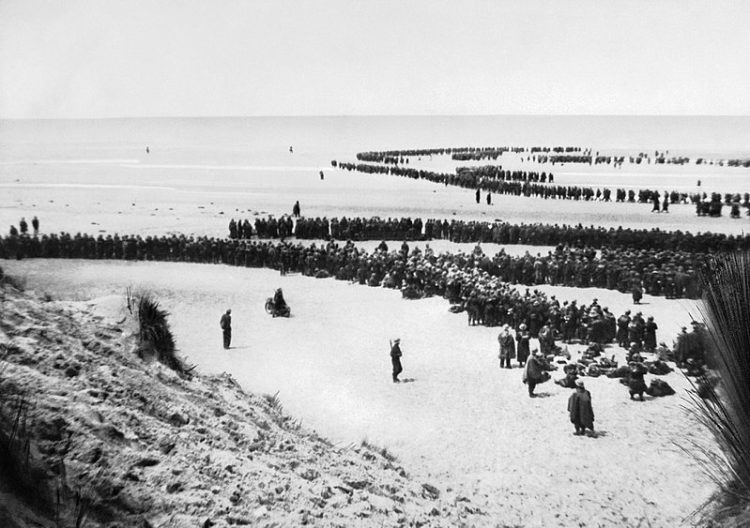Operation Dynamo, the evacuation of Dunkirk, began nearly 80 years ago today.
In May of 1940, British, French, and Belgian troops were trapped by the German army in western France. Blitzkrieg, or “lightning war” had proven terribly effective.
With the Allied armies nearing total collapse as the Germans neared the French coastline, the British launched at Dunkirk the largest evacuation and rescue mission that the world had ever seen.
WWII began in September 1939 when the Nazis invaded Poland. The British and French declared war on Germany and Britain sent the British Expeditionary Force (BEF) to the French border with Germany to sit all winter waiting for the inevitable invasion.
On May 10, 1940, a small German army swept through Holland, northern Belgium and into northern France. The Allies moved their troops there in an effort to meet the threat. But a much larger German force, their main effort, attacked via Luxembourg, broke through the French lines at Sedan, and began racing across northern France. The situation was rapidly getting out of control as the allies were in danger of being cut-off.
By the 20th of May, the situation was hopeless, the British tried to counterattack and blunt the German advance at Arras, but they were repelled. The BEF, three French armies, and the remains of the Belgian forces were pushed into a narrow corridor.
The British began to formulate plans for the evacuation of Dunkirk, which was chosen for its long sandy beaches.
Vice-Admiral Bertram Ramsay and his small staff in Dover Castle implemented Operation Dynamo. They would have to evacuate their men by sea. Yet, this would condense them into a small pocket, thus making them vulnerable to German artillery and airstrikes. Fortunately, the marshy areas around Dunkirk slowed the German armored advance and the Germans had to rely on their infantry units to bludgeon their way into the beaches.
Because of the gently sloping beaches, British destroyers could only get to a mile offshore: the men would have to be ferried by small boats to the larger ones. British civilian fishing boats, cockle boats, lifeboats, and sailing barges answered the Royal Navy’s call for help. The “Little Ships” proved to be life-savers helping to evacuate nearly 100,000 troops.
The Germans quickly saw what was happening and Dunkirk’s port installation and beaches became the targets of relentless airstrikes and artillery barrages. The RAF responded with ferrying all available fighter aircraft over the beaches to cover the withdrawal. The RAF gave the Germans a bloody nose, something that would play out in earnest in a few months during the Battle of Britain. Yet, since most of the aircraft engagements took place far from shore, the troops on the beaches saw very little of the aerial fighting and complained bitterly that the RAF had abandoned them.
When the BEF forces holding Calais surrendered on 26 May, the handwriting was on the wall. The Belgian army surrendered on 28 May, leaving a huge gap in the line. The French army held out at Lille until it ran out of food and ammunition. The 35,000 remaining men were forced to surrender on May 31. Nevertheless, the evacuation at Dunkirk continued and gained steam with each passing day until the 4th of June. Then, the 40,000 French troops that remained in the city were forced to surrender. France surrendered three weeks later.
Already have an account? Sign In
Two ways to continue to read this article.
Subscribe
$1.99
every 4 weeks
- Unlimited access to all articles
- Support independent journalism
- Ad-free reading experience
Subscribe Now
Recurring Monthly. Cancel Anytime.
Nearly 950 ships of all sizes were tasked to the risky and dangerous evacuation. A total of 233 were sunk including six destroyers; 19 more destroyers were damaged. The French themselves lost three destroyers. The RAF lost 145 aircraft including 42 of the vaunted Spitfires. The German aircraft losses numbered 156.
The British and French navies had hoped to evacuate 45,000 troops but by the end of Operation Dynamo. They reached and greatly surpassed that number: 338,266 troops were safely evacuated from the shores of Dunkirk, 239,555 from the harbor and 98,671 from the beaches.
The Germans proclaimed Dunkirk a great victory. The British BEF had lost 68,000 men killed, wounded, or captured and it had to abandon all of its heavy equipment. But by rescuing the bulk of its troops, it allowed them to fight another day and ultimately set the scene for D-Day four years later. Additionally, had the BEF been captured on the French shores, the Germans quite possibly could have forced an invasion of England.
Winston Churchill, the Prime Minister of Great Britain, perhaps put it best: “We must be very careful not to assign to this deliverance the attributes of a victory. Wars are not won by evacuations.”
Churchill’s famous address to Parliament on June 4th following the evacuation, perfectly summed up the British resolve:
“We shall go on to the end. We shall fight in France, we shall fight on the seas and oceans, we shall fight with growing confidence and growing strength in the air, we shall defend our island, whatever the cost may be. We shall fight on the beaches, we shall fight on the landing grounds, we shall fight in the fields and in the streets, we shall fight in the hills; we shall never surrender.”









